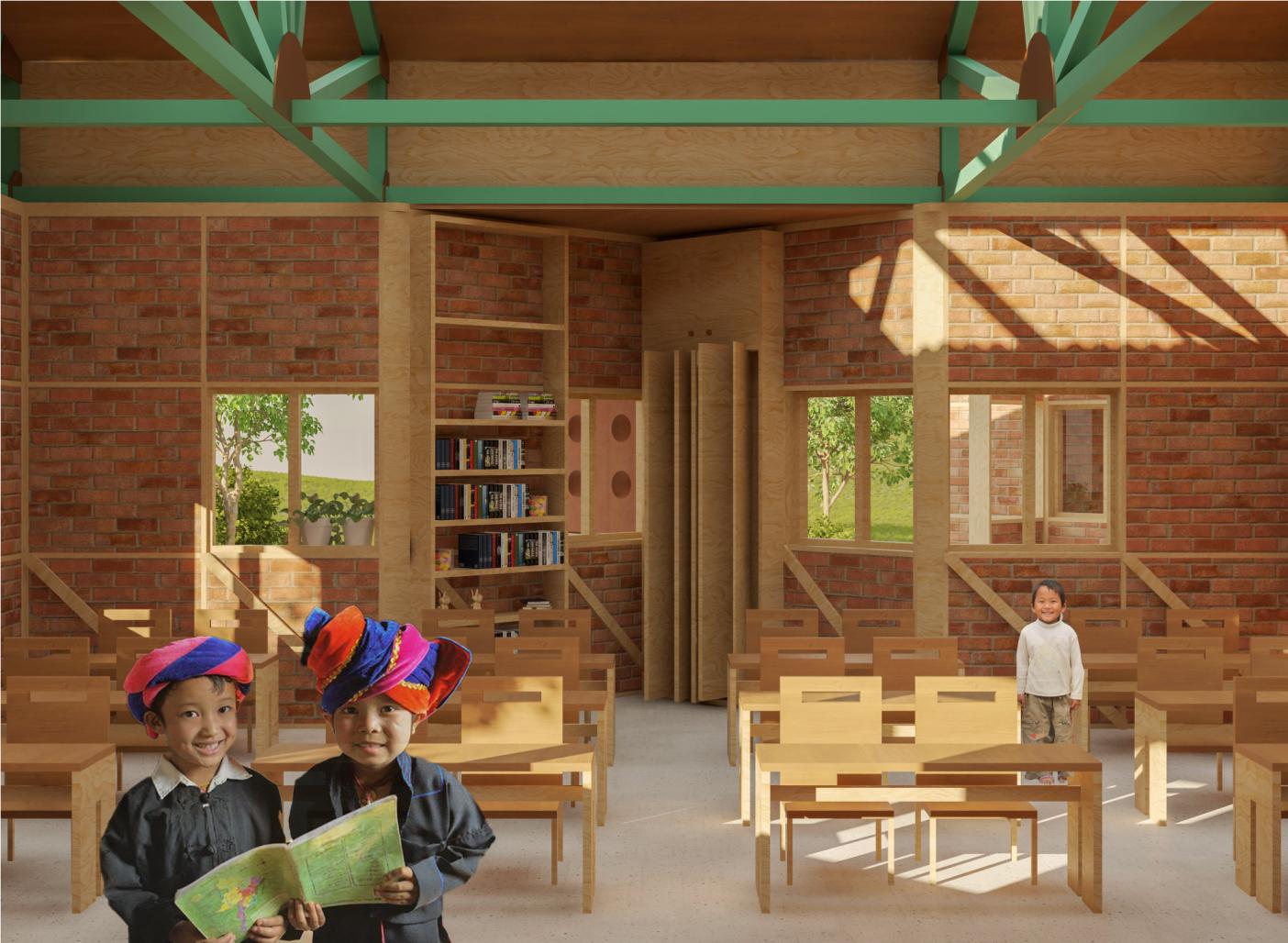Rooted in the topography and cultural rhythm of Nepal, this project proposes a modular school system designed to adapt, expand, and endure. Conceived as a response to both educational and environmental challenges, the design reimagines the idea of a school not as a fixed building, but as a living framework—a flexible structure that can grow with its community and transform in times of need.
1. The Concept of Adaptable Architecture
At its core, the design is grounded in two essential principles: adaptability and resilience. These principles are not only structural but also social. In a country shaped by seismic activity and geographical diversity, architecture must remain agile and inclusive—capable of responding to shifting landscapes, local materials, and community needs. The Nepal Learning Nest embodies this idea through a modular system that can be assembled, expanded, or rearranged by the very people it serves.
Each module follows a simple geometry that emphasizes repetition, efficiency, and participation. The system is designed to be intuitive, allowing local builders, parents, and even older students to take part in the construction process. In doing so, the school becomes more than a space for learning; it becomes a shared act of creation—a building built by the community, for the community.
2. Structural Logic and Material Honesty
The modular frame is the heart of the project. Made primarily from locally available materials such as bamboo, timber, and compressed earth blocks, it promotes sustainable construction while strengthening local craftsmanship. Every component is designed with ease of assembly in mind: the foundation can be laid with minimal excavation, the frame erected using lightweight connectors, and the walls filled with materials sourced from the immediate surroundings.
This honest use of materials celebrates the tactile beauty of Nepal’s vernacular architecture. The warm texture of rammed earth walls, the rhythmic lines of bamboo rafters, and the soft diffusion of natural light through woven panels together create a shelter that breathes with its environment.
Structurally, the system is engineered to respond to seismic challenges. The load is distributed evenly through the modular grid, while strategically placed crumple zones absorb impact during earthquakes. Each joint and connection detail is designed to flex rather than fracture, ensuring safety without sacrificing spatial openness.
3. Spatial Typologies and Flexibility
The modular approach allows for infinite combinations. By combining and rotating identical units, the system can generate a diverse range of spatial typologies—from compact classrooms to shaded corridors, courtyards, or outdoor learning spaces.
Classroom Modules provide bright, cross-ventilated spaces for focused study.
Creative Corners invite play, art, and hands-on exploration.
Courtyards and Verandas act as transitional zones—open yet protected, where children gather between lessons, teachers meet parents, and the community holds small events.
Multipurpose Halls emerge through the connection of multiple modules, forming larger enclosures for assemblies or emergency shelter.
Outdoor Reading Spaces and gardens nurture curiosity, connecting learning with nature.
This flexibility ensures that the architecture can adapt not only to physical constraints like topography or climate, but also to evolving pedagogical methods. The layout encourages interaction, observation, and shared learning, transforming every corridor or threshold into a potential classroom.
4. Dual Purpose: School and Shelter
One of the project’s most critical features is its emergency-ready transformation system. The modular design incorporates expansion capabilities that allow the intentional gaps between units to unfold into protected shelter spaces during earthquakes or natural disasters.
Each 12-square-meter interstitial zone can be rapidly converted into a safe area with minimal tools. The system’s crumple zone geometry ensures structural integrity while increasing sheltered capacity by up to 30% when activated. In moments of crisis, classrooms and courtyards transform seamlessly into emergency shelters—demonstrating the architecture’s inherent resilience and social value.
5. Daily Life and Social Integration
During regular operations, the school functions as a vibrant community hub. The covered veranda becomes the social heart—a shaded, flexible space where children play, learn, and connect with nature. The modular furniture, made of lightweight wood and recycled rubber, can be easily rearranged for different activities. The flooring incorporates embedded educational games, merging play and pedagogy in everyday learning.
Here, architecture supports education not through high technology but through spatial generosity and empathy. The design respects the rhythm of children’s lives: the open courtyard for laughter, the shaded corner for quiet reading, the verandas for observation and exchange.
By embracing openness and transparency, the school nurtures inclusivity and trust—values that extend beyond the classroom into the broader social fabric.
6. Construction as Education
The process of building the school becomes a learning journey in itself. Through workshops and on-site training, community members acquire construction skills that can be applied beyond the project. Students witness how materials transform into structure, understanding architecture as a living, evolving craft.
In this way, the project strengthens local resilience not only through design but through empowerment. It positions education and construction as parallel forms of learning—one nurturing the mind, the other nurturing the community.
7. Responding to Nepal’s Landscape
Nepal’s terrain is characterized by steep slopes, remote villages, and diverse climatic conditions. The modular system’s lightweight and scalable design allows it to adapt to these variations effortlessly. Whether perched on a hillside or nestled in a valley, the structure maintains stability and comfort through passive environmental strategies.
Natural ventilation, deep overhangs, and shaded verandas regulate temperature and light throughout the year. Rainwater harvesting systems are integrated into the roof, supporting sustainable water management during monsoon seasons. Each module becomes part of a larger ecological cycle, emphasizing harmony between architecture and landscape.
8. The Masterplan: A Village of Learning
When combined, the modules form not just a school but a micro-village of knowledge. The masterplan arranges clusters of classrooms and courtyards around shared open spaces, connected by pathways that encourage exploration and social interaction.
This decentralized organization mirrors traditional Nepali settlement patterns, where community life revolves around communal courtyards. The school thus becomes a familiar yet forward-looking environment—rooted in local identity while offering new opportunities for growth and connection.
9. A Framework for the Future
Beyond its immediate function, the Nepal Learning Nest proposes a model for future educational infrastructure in seismic and resource-constrained regions. Its simplicity allows it to be replicated, modified, and scaled according to need—whether as a primary school, community center, or post-disaster housing framework.
By integrating social, environmental, and structural resilience into one adaptable system, the design becomes both architecture and methodology—a way of building that celebrates participation, learning, and care.
10. More Than a School
Ultimately, this project is not just about constructing classrooms; it is about cultivating a sense of belonging and possibility. In Nepal, where education often serves as the bridge between tradition and modernity, the Learning Nest becomes a beacon of hope—a place where the next generation can grow, dream, and rebuild their communities together.
It stands as an invitation: to learn, to build, and to imagine a future where architecture empowers people rather than isolates them. A structure made simple, so that everyone can build it—and build with it.
2025
The modular design incorporates emergency-ready expansion capabilities by transforming the intentional gaps between units into instant shelter spaces during earthquakes or disasters. These 12-square-meter interstitial zones can be rapidly converted into protected areas.
Designer: Ha Gia Bao, Nguyen Nguyen Khoi, Nguyen Ngoc Minh Anh
Supervisor: Dr. Le Thi Thu Huong
Voted 0 times
















